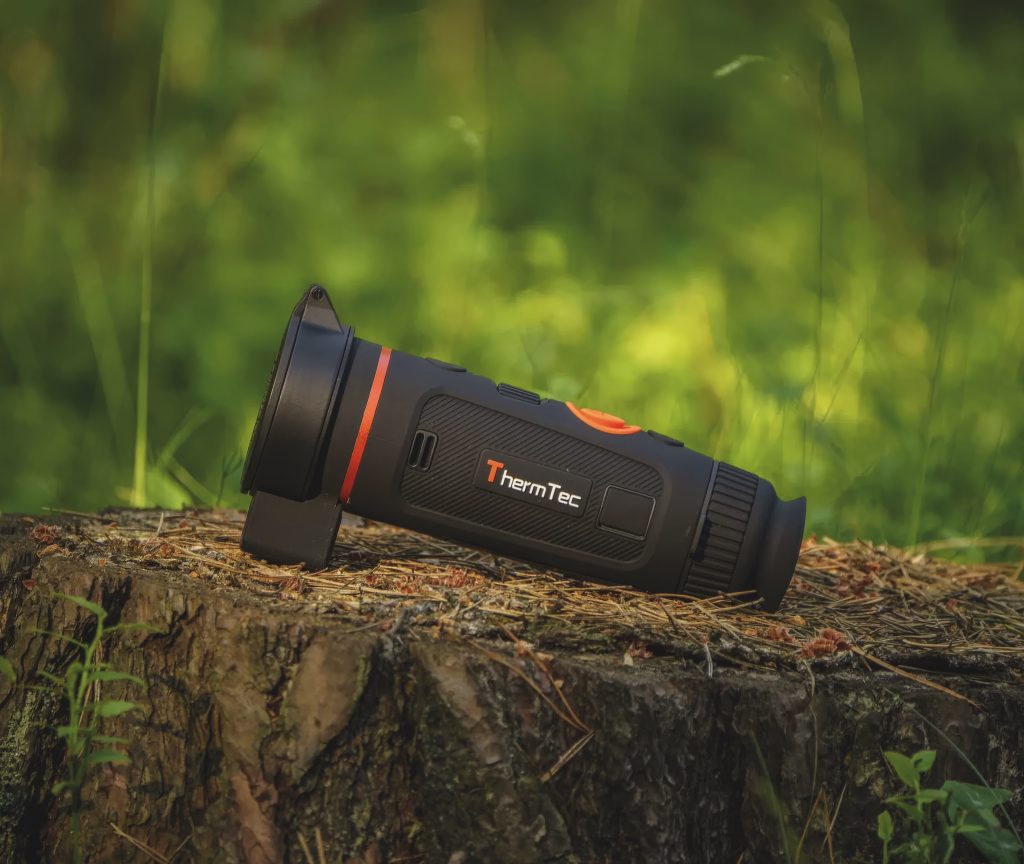Win CENS ProFlex DX5 earplugs worth £1,149 – enter here
Add on-devices for scopes: reviewing three of the best
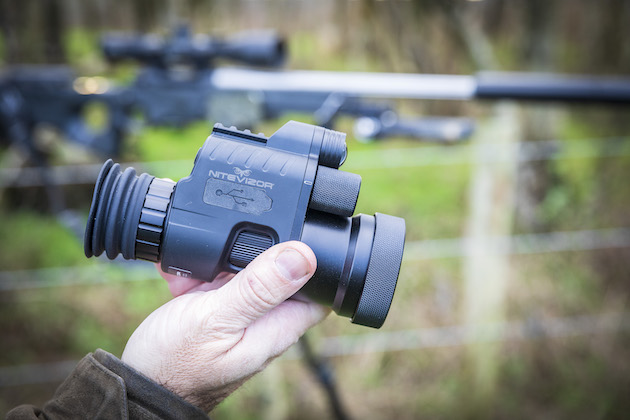 Mark Ripley, Add on NV Scope Test - Nitevizor
Mark Ripley, Add on NV Scope Test - Nitevizor
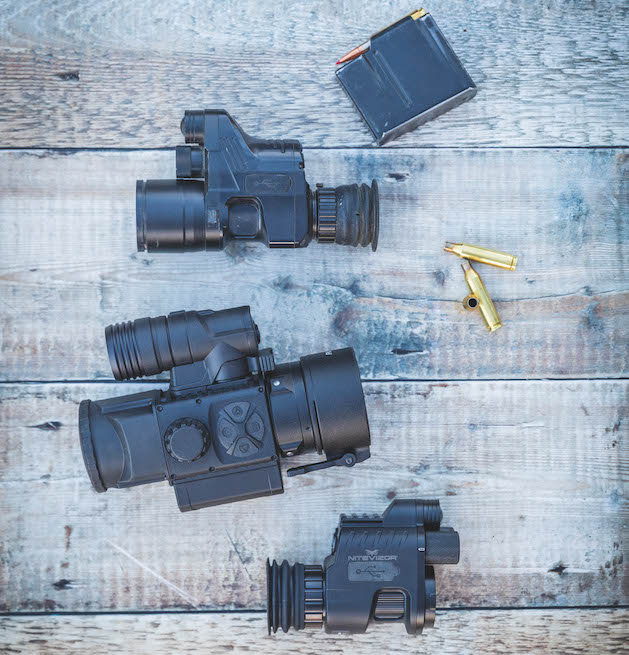
Top – Pard 007, Middle PulsarF455 S, Bottom Nitevizor.
Add-on devices for scopes
So why are add-on devices for scopes so useful? One of the biggest inconveniences when using a night-vision or thermal scope is that their performance during the day is never going to be as good as a traditional glass optic. Although several night-vision scopes now offer colour day screens, and can be used perfectly well during the day, for precision or long-range shooting they don’t really cut it. (Read our best practice for using thermal imagers humanely. .)
This leaves you with just a few other options. Firstly, you could buy a rifle dedicated purely to night use, but this is an added expense and may mean taking out two rifles in certain situations. Secondly, you could use a quick-release scope mount on your day scope. However, not all night-vision scopes have mounting systems that reliably return to zero. The final, most convenient option is to use add-on devices for scopes . This allows you to retain all the benefits of your standard day scope, while adding night-vision capability when required.
Early add-on devices for scopes proved to be of limited performance in comparison to a dedicated night scope, but times have changed and some impressive units are now available at competitive prices. This truly is the vanguard of shooting optics. (Read our list of best binoculars for hunting.)
1. Pulsar F445S RRP £1,099.95
First up, we have the Pulsar F455S. This is the only front-mounted scope add-on in the line-up. Although this unit is the heaviest of the three at around 830g, with the added weight close to the balance point of the rifle, it doesn’t overly affect pointability. The plus point of a front-mounted unit is that it doesn’t make any difference to your head positioning behind the scope, as in the case of a rear-mounted unit.
Performance is very good, with the ability to see out to 500m with the on-board infrared illuminator. The F455S is also easy to use and comes complete with a small, stock-mounted remote control for ease of application in any shooting position. Powered by an IPS7 battery pack, it gives up to nine hours of use — more than enough for a night on the foxes.
There is also an adaptor that allows the F455S to be used as a night-vision spotter before quickly attaching it to the scope to take a shot. This is thanks to its quick-fitting, bayonet-style mounting system; the Pulsar proved quick and easy to fit to the rifle, showing no obvious point-of-impact shift.
I was familiar with this unit, having previously owned the earlier F155 model, which was similar although not as good as this latest offering. Taking it out foxing, it proved an easy and effective device, allowing me to put a pair of foxes in the bag, one of which was around 180m, although any further out than that the image became a little grainy.
As with all Pulsar units, it includes the ability to record photos and videos to its inbuilt memory and supports the Stream Vision app, allowing real-time footage to be viewed on a smartphone or tablet via WiFi. All in all, it’s a well-made, reliable and easy-to-use unit that has no negative impact on a rifle’s normal use. Ranking 9/10
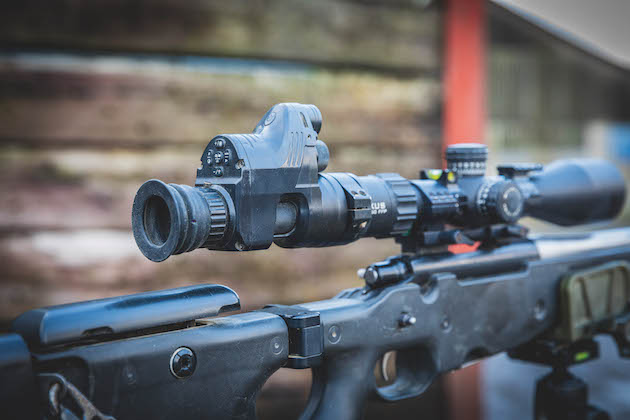
The Pard NV007A offers an affordable and lightweight option for pest control
2. PARD NV007A RRP £328.95
The Pard NV007A took the market by storm a few years ago, offering good night-vision capabilities at an amazing price point. The Pard units are now available in a couple of different options: a 12mm 1x magnification and a 16mm 4x magnification. The unit on test is a version of the 16mm with built-in 4x magnification.
If I were to buy this unit again, I would buy the 12mm 1x magnification model as the 4x option is a little too much with the day scopes I’m using, most of which already have a minimum magnification of 5x. Adding the additional 4x magnification of the Pard makes target acquisition quite a bit more difficult.
The main drawback to rear add-on units is that they cause you to position your head further back on the stock than usual, which takes a bit of getting used to. The Pard can also be a bit tricky to focus clearly, but once it’s set up correctly and you’re familiar with it, the picture quality is very good. The unit uses a colour day-screen mode that is great for filming daytime hunts and saving photos and video to a micro SD card.
At only 250g, it adds no noticeable weight to the rifle and a single 18650 battery is enough to power it for up to eight hours. The on-board illuminator is sufficient for use out to 200m, but an aftermarket illuminator will greatly increase its usable range.
Using this unit at night, I’ve shot many foxes out to 320m with no problem. One evening, I had the hopeless task of shooting a problem fox in the lambing season. Charlie appeared after dusk on the other side of a valley. The only chance of a shot would be from at least 270m while it was blowing a gale. I shot the fox at 310m in a 20mph crosswind — a most satisfying shot and one that would have been almost impossible with a dedicated night vision scope Ranking 8/10
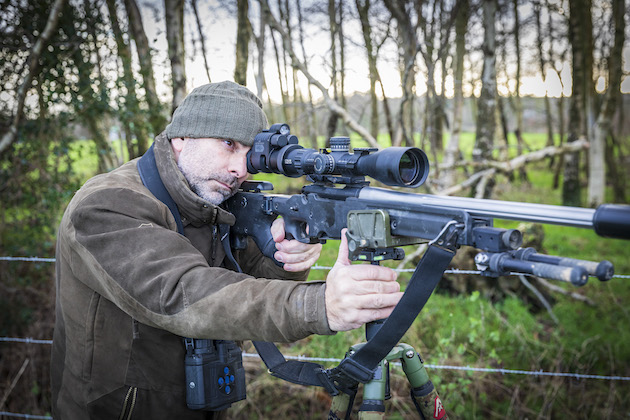
Mark Ripley rates the NiteVizor VP200XTR slightly ahead of its main rival, the Pad NV007A, for its build and image quality.
3. NiteVizor VP200XTR RRP £509.99
The NiteVizor VP200XTR is a rear add-on that is very similar to the Pard NV007A in terms of looks as well as its functions. The NiteVizor boasts a slightly better picture quality than the Pard and uses two 18650 batteries to give extended battery life. Put simply, this unit does everything the Pard will do and more, offering additional colour palettes and a range of different reticules that can be superimposed over the day scope’s reticule for easier target acquisition at night.
It also incorporates a better bayonet fitting with a quick-release mounting system, which I prefer to that of the Pard — and it weighs only 100g more.
The NiteVizor has an optical magnification of 4x, so will be best suited to a scope with a minimum magnification of 3x to 4x to retain a reasonable field of view. It would be nice to see this unit offered in a 1x magnification option, too, so it would be better suited to day scopes with a higher minimum magnification, such as mine.
Unfortunately, I didn’t have as much time to use this unit as I would have liked, but did manage to find one fox over the Christmas period. I must confess to adding an additional infrared illuminator to these units as a matter of course, as I’m sure many of you will, so I’m not entirely sure if this shot would have been possible with the standard IR.
However, waiting out on the edge of a wood on a cold December evening well after dark, I was rewarded with a single fox leaving the cover of the wood and heading out across the open field away from me. Giving it a shout as it neared the edge of the field, I duly stopped it broadside before squeezing the trigger. To my surprise, the fox was a little shy of 210m — further than I’d thought.
Although this add-on is more expensive than its closest rival, the Pard, it seems to be better built, with a sharper image, which justifies the extra money. Ranking 8.5/10
In conclusion
I’d be happy to use any of these add-on devices for scopes for foxing, rabbiting or ratting. Each has its own pros and cons, so it’s up to you to decide which best suits you and your budget. Although the Pulsar is the most expensive, you have the added bonus of being able to front-mount the unit. The NiteVizor proves that excellent quality night vision doesn’t have to break the bank, while the Pard provides an affordable and lightweight option.
My only advice would be, if you’re using any of these units beyond 90m, get an infrared illuminator, a clever bit of kit that provides invisible ambient light, therefore increasing the performance and range of your night-vision system.
Related Articles
Get the latest news delivered direct to your door
Subscribe to Shooting Times & Country
Discover the ultimate companion for field sports enthusiasts with Shooting Times & Country Magazine, the UK’s leading weekly publication that has been at the forefront of shooting culture since 1882. Subscribers gain access to expert tips, comprehensive gear reviews, seasonal advice and a vibrant community of like-minded shooters.
Save on shop price when you subscribe with weekly issues featuring in-depth articles on gundog training, exclusive member offers and access to the digital back issue library. A Shooting Times & Country subscription is more than a magazine, don’t just read about the countryside; immerse yourself in its most authoritative and engaging publication.







